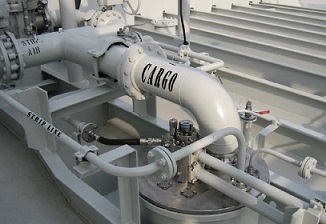Fuel oils are loaded through deck fill connections that have sample connections provided to allow the fuel to be sampled as it is taken aboard. HFO is placed in storage tanks fitted with heating coils. In preparation for use, HFO is transferred to the fuel oil settling tanks via FO transfer pumps, which are equipped with a suction strainer. Piping is so arranged that the pumps can convey fuel between storage tanks and the deck connections for offloading. Settling tanks are used to sanction gross water and solids to settle on the bottom.
It is also common for a parcel of fuel oil when permitted to settle in a tank; the viscosity of the liquid can progress. This development results in increased input torque requirements and potentially influence the delivered product. In positive displacement pumps‚ the delivered flow will expand, and in centrifugal pumps, that all delivered will contract. Therefore, it is essential to size any fuel pump consider the characteristics of the fluid‚ pressure‚ supply and operational objectives as well as normal environmental conditions.
Fuel Oil transfer within machinery space:
The Chief Engineer should have the crew well know and understand the following matters to prevent oil leakage:
No Fuel Oil transfer into settling tanks shall be carried out in port or at anchorage in principle. However transfer of Fuel Oil between settling tank and storage tank is permitted provided that the transfer is necessary due to unexpected long stay in port, large consumption of fuel by cargo operation and imperative use of FO shifter during heating FO in storage tank.
During FO transfer into settling tanks in port or at anchorage in an unavoidable cause, if any abnormality is discovered on the oil level, the pump shall be shut down immediately, and the matter shall be reported to the engineer on watch the causes shall be located and thoroughly investigated. And the transfer work shall not be restarted until the causes have been completely removed.
When the FO transfer pump is operated manually, the oil level shall be monitored all the time.
When a normally closed valve in the FO-transfer-related valves must be operated, notices shall be put up beforehand in the machinery control room and near the valve to show that the valve is under works. The engineer on the watch shall confirm that the valve is closed, and the FO transfer pump is set to automatic mode after completion of manual operation.
Operational conditions of the remote level gauges, automatic shutdown devices, and high-level alarms shall be confirmed every day according to the Checklist.
Transfer between Fuel Oil storage tanks
When Fuel Oil transfer work between FO storage tanks or FO transfer work through piping on the deck is carried out, the Chief Engineer shall have the crew well know and understand the following matters, and take preventive measures against marine pollution :-
In principle, FO transfer shall not be carried out while the vessel is in port or at anchorage,
-
If Fuel Oil transfer is carried out while the vessel is in port or at anchorage in an unavoidable case, the work shall be executed with caution.
-
Closure of deck scuppers and watchkeeping shall be practiced without fail.
The full list of equipment and supplies should be listed in the vessel's Shipboard Oil Pollution Emergency Plans (SOPEP) Manual. Oil Spill Removal Equipment should be marked with two red bands and should be kept in a convenient storeroom. The storeroom should be marked to indicate the contents.
The Oil Spill Removal Equipment should not be used for any other purpose. During cargo operations and bunkering, the equipment and supplies should be ready for immediate use.
Oil Spill Removal Equipment should include:-
sorbents
-
non-sparking hand scoops, shovels and buckets
-
emulsifiers for deck cleaning
-
protective clothing
-
a minimum of one non-sparking pump with hoses
-
scupper plugs.
Related Information
Acceptance / rejection of fuel in a quality dispute
Operational guideline during bunkering
Bunker fuel sulfer limit of 3.50 % - Fuel Oil Regulations Frequently asked questions
Ships bunkering guideline- planning, preparation, safety checks & confirmation
Bunkering arrangement and safety factors onboard
Bunkering safe procedure and detail guideline for ships
How to keep bunkering record ?
Precautions prior transferring fuel oil into storage tanks
Treatment of waste oil and oily bilge
Bulk liquid cargo handling - Ship to shore safety checklist
General guidance for oil tankers
Tanker equipment and machinery
Pumproom procedure
Pumproom inspection for tankers
Treatment for waste oil or oily bilges
Oil pollution prevention method
General precautions for tankers
Tanker equipment and machinery
General guidance for oil tankers
Crude oil washing for tankers

Other info pages !
Ships Charterparties Related terms & guideline
Stevedores injury How to prevent injury onboard
Environmental issues How to prevent marine pollution
Cargo & Ballast Handling Safety Guideline
Reefer cargo handling Troubleshoot and countermeasures
DG cargo handling Procedures & Guidelines
Safety in engine room Standard procedures
Questions from user and feedback Read our knowledgebase
Home page

ShipsBusiness.com is merely an informational site about various aspects of ships operation,maintenance procedure,
prevention of pollution and many safety guideline. The procedures explained here are only indicative,
not exhaustive in nature and one must always be guided by practices of good seamanship.
User feedback is
important to update our database. For any comment or suggestions please Contact us
Site Use and Privacy - Read our privacy policy and site use information.
//Home //Terms and conditions of use
Copyright © 2015 www.shipsbusiness.com All rights reserved.



